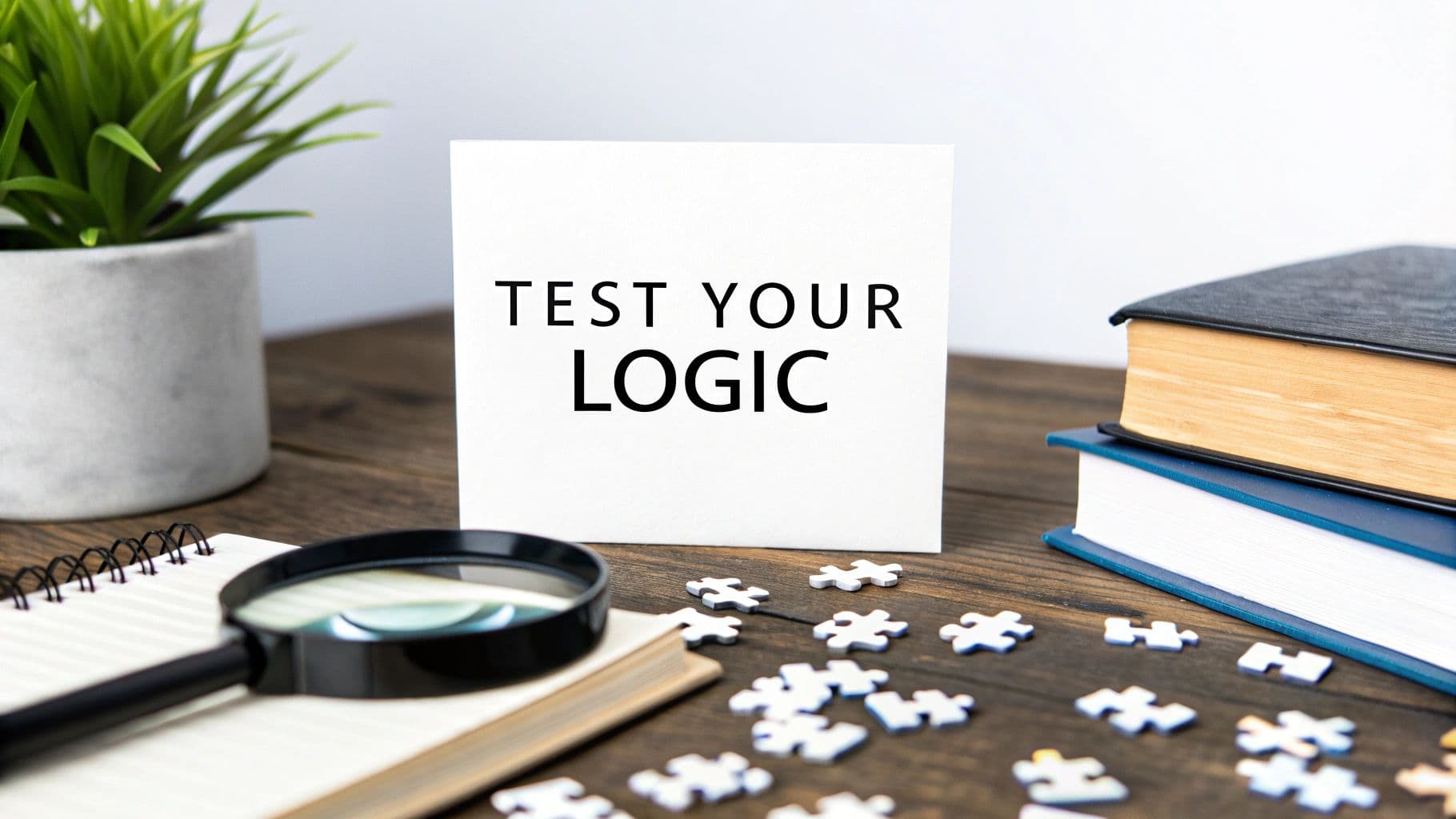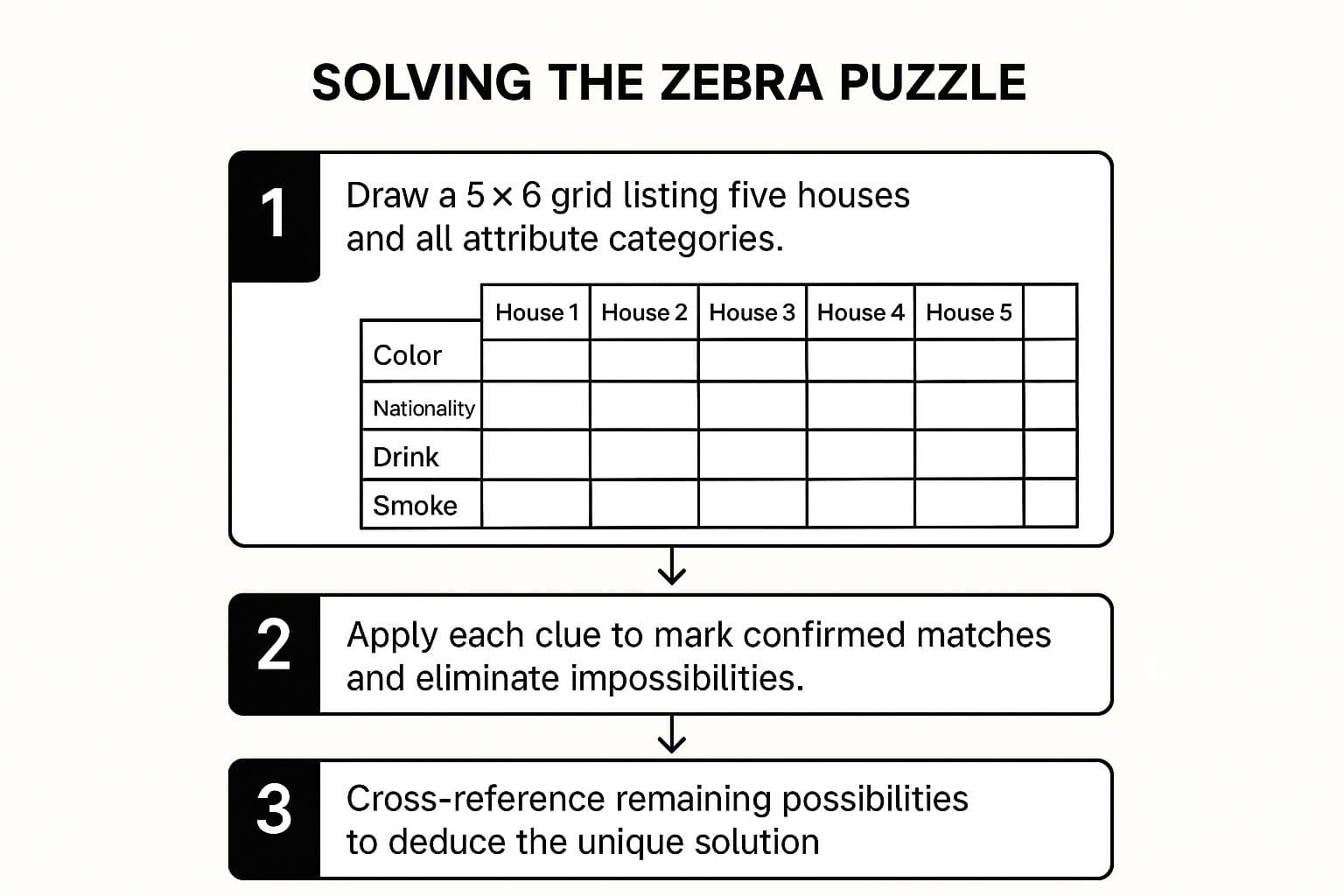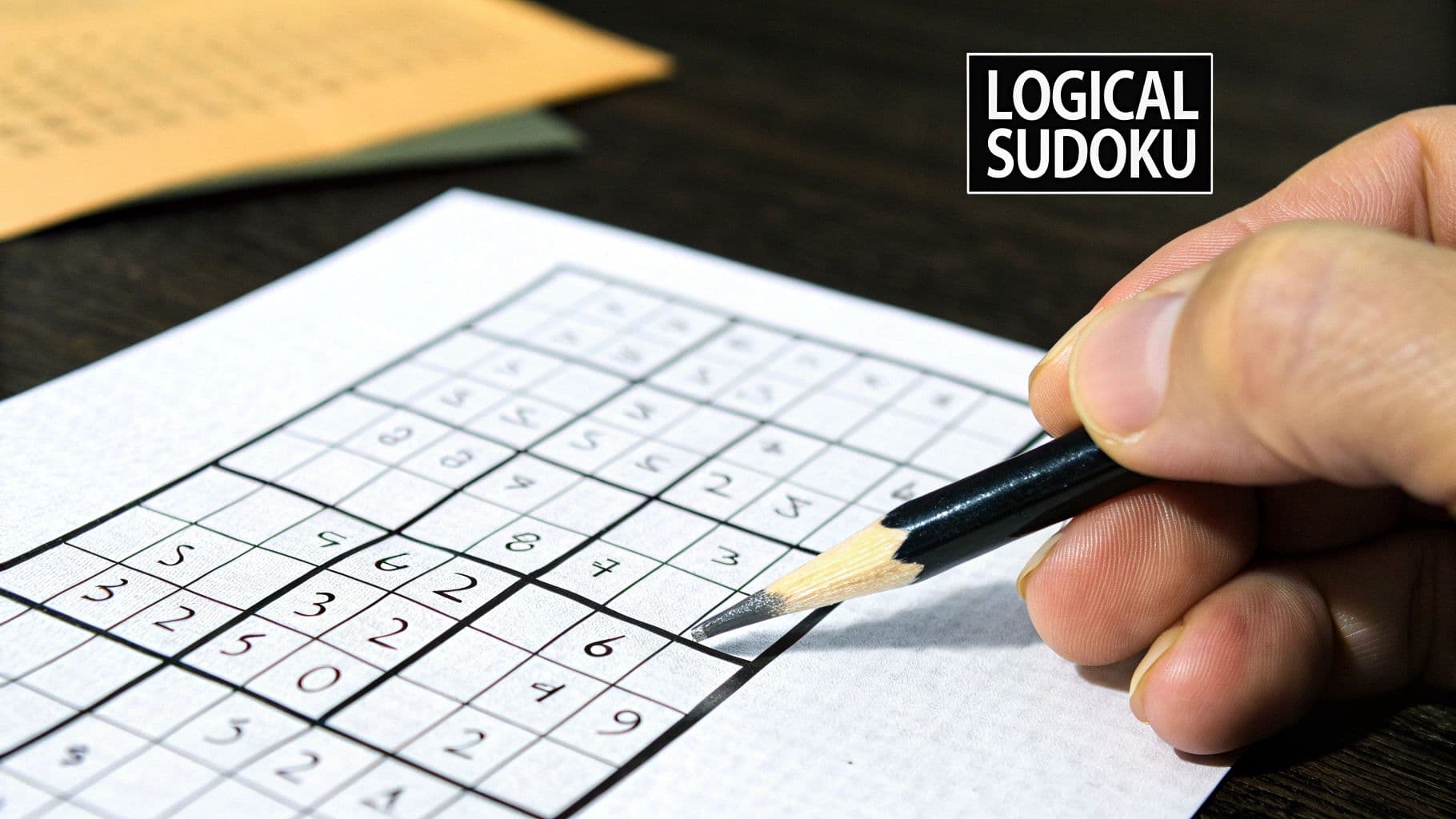8 Puzzles to Test Your Deductive Reasoning Skills in 2025
Ready to test your deductive reasoning? Sharpen your mind with 8 classic logic puzzles, from Sudoku to Einstein's Riddle, complete with solving tips.

Deductive reasoning is the cornerstone of sharp, analytical thinking. It's the ability to start with a general principle or a set of established premises and arrive at a specific, guaranteed conclusion. This skill is critical not just for solving brain teasers, but for navigating complex challenges in high-stakes fields like management consulting, investment banking, and product strategy. Unlike inductive leaps or educated guesses, deduction is a precise process of elimination and logical certainty, forming the bedrock of sound decision-making.
This article is more than a simple collection of puzzles; it's a structured gauntlet designed to let you test your deductive reasoning abilities in a practical, hands-on way. We will dissect eight distinct types of logic puzzles, from the classic Zebra Puzzle to the visual challenge of Nonograms. For each, we'll break down the core mechanics, offer actionable strategies to improve your performance, and reveal the specific cognitive skills you're actively building.
Whether you're an MBA student preparing for case interviews, an aspiring analyst, or a seasoned professional looking to sharpen your analytical edge, this curated roundup provides the tools you need. You will learn to assess your current skills, identify areas for improvement, and forge a clear path toward logical mastery.
1. Zebra Puzzle (Einstein's Riddle)
The Zebra Puzzle, often called Einstein's Riddle, is a classic logic problem that serves as a rigorous workout to test your deductive reasoning. The puzzle presents a scenario with five houses, each distinguished by a unique color, inhabitant nationality, pet, beverage, and cigarette brand. Armed with a list of 15 clues, your task is to deduce who owns the zebra and who drinks water.
This puzzle is a pure test of logic; it contains no tricks. Every piece of information needed for the single correct solution is provided. Its value lies in forcing you to manage multiple variables and constraints simultaneously, making deductions by systematically eliminating possibilities. This skill is highly prized in fields like consulting, finance, and technology, where analysts must synthesize complex datasets to arrive at sound conclusions.
How to Tackle the Puzzle
The most effective method for solving the Zebra Puzzle is to create a logic grid. This matrix allows you to visually track every possible combination of attributes (nationality, house color, pet, etc.) and systematically fill it in based on the clues.
- Start with Direct Clues: Begin with clues that give you a direct, concrete relationship, such as "The Englishman lives in the red house."
- Use Process of Elimination: As you confirm a piece of information, you can eliminate that option for all other categories. If House #3 is the red house, it cannot be green, blue, yellow, or ivory.
- Revisit Clues: The true power of deductive reasoning shines when you revisit clues after making new deductions. A clue that seemed unhelpful initially might become the key to unlocking the next step.
The infographic below outlines the fundamental process flow for solving the puzzle.

This systematic, three-step approach ensures that every deduction is based on confirmed facts rather than guesswork, which is the core of logical problem-solving. It's a structured technique often used to prepare for the types of analytical challenges found in strategic thinking interview questions.
2. Sudoku
Sudoku is a number-placement puzzle that serves as an excellent way to test your deductive reasoning through pure logic. The puzzle consists of a 9x9 grid, further divided into nine 3x3 subgrids, with some cells pre-filled with digits. The objective is to fill the entire grid so that each row, column, and 3x3 box contains all the digits from 1 to 9 exactly once.
This puzzle is a quintessential exercise in logical elimination and constraint satisfaction. It requires no mathematical skill, only the ability to identify patterns and systematically rule out possibilities until the single correct solution emerges. This makes it a powerful tool for sharpening the analytical thinking required in data-driven fields, where professionals must filter through information to find clarity and make precise decisions. Its widespread adoption, from newspapers like The New York Times to brain training apps, highlights its value in cognitive development.

How to Tackle the Puzzle
A systematic approach is crucial for solving Sudoku efficiently, moving from simple deductions to more complex ones. The key is to avoid guessing and ensure every number placed is based on logical certainty.
- Scan for Obvious Placements: Start by identifying numbers that can only go in one possible cell within a given row, column, or 3x3 box. This is often called finding "naked singles."
- Use Penciling and Elimination: Use small "pencil marks" to note all possible candidate numbers for an empty cell. As you place numbers, you can eliminate those candidates from other cells in the same row, column, and box.
- Identify Hidden Patterns: Look for "hidden singles," where a specific number can only fit into one cell within a box, even if that cell has other candidates. This technique forces you to shift perspective from the cell to the number itself.
By layering these techniques, you build a chain of logical deductions. Each number you place provides new information, unlocking the next step in the puzzle and reinforcing the core principles of deductive problem-solving. This incremental, logic-based process mirrors the analytical frameworks used in case study interviews for consulting and finance.
3. Knights and Knaves Logic Puzzles
Knights and Knaves puzzles are a classic category of logic problems designed to test your deductive reasoning by analyzing contradictory statements. Popularized by logician Raymond Smullyan, these puzzles place you on an island inhabited by knights who always tell the truth and knaves who always lie. Your goal is to determine each person's identity based solely on their statements.
These puzzles are an excellent exercise in propositional logic and truth-value analysis. They force you to evaluate the internal consistency of statements and how they relate to the fixed rules of the system. This type of analytical thinking is essential in fields like software engineering and law, where one must untangle complex, conditional statements to find a single, verifiable truth.

How to Tackle the Puzzles
The key to solving these puzzles is to test hypotheses. By temporarily assuming one character's identity, you can trace the logical implications of that assumption. If it leads to a contradiction, the assumption must be false.
- Assume and Test: Start by assuming one person is a knight. Analyze their statement from that perspective. If their statement leads to a logical contradiction (e.g., they would have to be a knave), your initial assumption was incorrect.
- Identify Paradoxical Statements: Look for statements that only one type of person could possibly make. For example, no one on the island can ever say, "I am a knave," because a knight wouldn't lie and a knave wouldn't tell the truth.
- Cross-Reference Claims: When one person makes a claim about another, use it to build a chain of deductions. If you assume Person A is a knight, then their statement about Person B must be true. Does this align with what Person B says?
This systematic approach of creating and falsifying hypotheses is a powerful tool. It mirrors the diagnostic processes used in medicine and engineering and is a core skill for anyone in an analytical role. Many consulting and finance interviews include logic problems similar to these to assess a candidate's ability to think structurally under pressure.
4. River Crossing Puzzles
River crossing puzzles are classic logic problems that present a scenario where a group must transport items or individuals across a river, subject to a specific set of constraints. These puzzles, like the famous "Fox, Chicken, and Grain," are an excellent way to test your deductive reasoning by requiring you to think through a sequence of actions where each step must satisfy multiple conditions.
The core challenge lies in state-space management. You must move from an initial state to a goal state without ever entering a forbidden state, such as leaving the fox alone with the chicken. This forces you to think several steps ahead, anticipate consequences, and understand dependencies. The skills honed here are directly applicable in fields like project management and operations, where managing resources under tight constraints is a daily reality.
How to Tackle the Puzzle
The most effective way to solve river crossing puzzles is to map out the possible states and the transitions between them. This prevents you from getting stuck in a loop or overlooking a simple solution.
- Draw a State Diagram: Visualize the problem. Draw circles or boxes for each valid combination of entities on either side of the river and connect them with arrows representing a boat trip.
- Identify Critical Constraints: Determine the rules that limit your moves. In the "Missionaries and Cannibals" puzzle, the key constraint is that cannibals can never outnumber missionaries on either bank.
- Work Forwards and Backwards: Sometimes, thinking backward from the final goal can reveal the necessary preceding steps, simplifying the path forward from the start.
- Track Your Moves: Keep a record of the states you have already visited. This ensures you don't waste time repeating moves and helps you identify when you are in a cycle.
This structured approach transforms a potentially confusing puzzle into a manageable sequence of logical steps. This method is a core component of many structured problem-solving techniques used to deconstruct complex business challenges.
5. Logic Grid Puzzles
Logic Grid Puzzles are the quintessential way to test your deductive reasoning in a structured format. These puzzles present a scenario with several categories (like names, cities, and jobs) and a list of clues detailing the relationships between them. Your objective is to use these clues to match every item in one category to a single item in each of the others.
These puzzles formalize the process of elimination into a visual grid. They are essentially generalized versions of the Zebra Puzzle, ranging from simple 3x3 grids for beginners to complex matrices that challenge even seasoned logicians. Their value lies in training your brain to manage interconnected variables, make inferences, and maintain logical consistency, skills essential in fields like law, engineering, and data analysis, which often feature in the LSAT's analytical reasoning section.
How to Tackle Logic Grid Puzzles
The grid is your primary tool. It provides a visual map of every possible pairing, allowing you to systematically mark confirmed matches (often with an "O") and impossible combinations (with an "X"). This structured approach turns a complex web of information into a solvable problem.
- Start with Direct Clues: Identify and mark clues that give you a definite link, such as "Anne's favorite color is blue." Place an "O" in the box where Anne and Blue intersect, and "X"s in the rest of Anne's row and the Blue column within that grid section.
- Use the Transitive Property: Look for chain reactions. If you deduce that the biologist is from Dallas, and you already know the biologist is named Sarah, you can conclude that Sarah is from Dallas.
- Cross-Reference and Revisit: Every time you confirm a match or an elimination, scan the entire grid. The new information might make a previously ambiguous clue suddenly useful, unlocking the next step in the puzzle.
Platforms like Puzzle Baron offer thousands of these puzzles, providing a perfect training ground for anyone looking to sharpen their analytical skills.
6. Mastermind
Mastermind is a classic code-breaking game that provides a powerful way to test your deductive reasoning. The game challenges one player to guess a secret code, which consists of a sequence of colored pegs, within a set number of attempts. After each guess, the code-breaker receives feedback indicating how many pegs are the correct color in the correct position and how many are the correct color but in the wrong position.
This puzzle is a pure exercise in hypothesis testing and logical elimination. Originally a board game invented in 1970, its principles are now seen in modern variations like the viral word game Wordle. The game forces you to build upon partial information, refine your hypotheses with each turn, and systematically narrow down possibilities. This structured approach to problem-solving is invaluable in fields like software development, data science, and strategic planning, where decisions must be made based on iterative feedback.
How to Tackle the Puzzle
The most efficient way to solve a Mastermind puzzle is by applying a systematic strategy that maximizes the information gained from each guess. Avoid random guessing and instead focus on methodical elimination.
- Make an Informative First Guess: Start with a guess that uses distinct colors, such as four different ones. This approach maximizes your chances of gathering broad information about the colors present in the secret code.
- Track Guesses and Feedback: Systematically record every guess and the corresponding feedback. This record is your database for making logical deductions and eliminating impossible combinations for future turns.
- Use Process of Elimination: The feedback is your primary tool. If a guess with a blue peg receives zero feedback for correct colors, you can confidently eliminate blue from all future possibilities.
- Formulate and Test Hypotheses: Use the feedback from previous rounds to create logical hypotheses. For example, "If the red peg was in the correct position in guess #1, then my next guess should test that assumption."
This systematic process of guessing, receiving feedback, and deducing is a core skill taught in many computer science algorithms courses. It mirrors the scientific method and is a foundational skill for anyone in an analytical role. Developing this structured thinking can significantly enhance how you articulate your thought process, a key element in mastering communication skills for interviews.
7. Nonogram (Picross)
Nonograms, also known as Picross or Griddlers, are picture logic puzzles that serve as a compelling way to test your deductive reasoning. The puzzle involves a grid where you must color cells based on numbers provided at the side of each row and column. These numbers describe the lengths of consecutive filled-cell runs, forcing you to deduce which cells to fill to reveal a hidden image.
This puzzle is a pure exercise in logical inference and constraint satisfaction. There is no guesswork involved; every filled or empty cell is determined by logically processing the given numerical clues. Its value lies in training your brain to cross-reference information between rows and columns, identifying certainties and eliminating possibilities. This skill is critical in data analysis, coding, and strategic planning, where conclusions must be drawn from intersecting data points.
How to Tackle the Puzzle
The most effective way to solve a Nonogram is by starting with the most restrictive clues and building from there. Your goal is to find "forced" cells that must be either filled or empty, regardless of other possibilities.
- Start with Certainty: Identify rows or columns with large numbers. For example, a "10" in a 10-cell row means you can fill the entire line. Similarly, a clue like "4 1 4" in a 10-cell row (4+1+4=9) leaves only one arrangement possible.
- Use the Overlap Technique: This is a core deductive strategy. If a row is 10 cells wide and has a clue of "7", you can count 7 cells from the left and 7 from the right. The cells where these two counts overlap (the middle four cells) must be filled.
- Mark Empty Cells: Just as important as filling cells is marking those that must be empty, often with an 'X'. This narrows down the options for remaining clues and prevents mistakes. Constantly cross-referencing between rows and columns after each new deduction is key.
The puzzle's progression from simple, certain deductions to more complex, interdependent ones provides an excellent, scalable challenge for your logical mind. Its visual nature also makes the deductive process uniquely engaging, as a coherent picture slowly emerges from pure logic.
8. Boolean Satisfiability (SAT) Puzzles
Boolean Satisfiability puzzles, or SAT problems, are a foundational challenge designed to test your deductive reasoning at a computational level. The core task is to determine if a given Boolean formula, made of variables and logical operators like AND, OR, and NOT, can be made true by assigning specific true/false values to its variables.
While originating in theoretical computer science, SAT problems are more than an academic exercise. They force you to navigate complex logical constraints and dependencies, a skill critical for roles in software engineering, circuit design, and even operations research. Solving them requires systematically deducing a valid assignment of values that satisfies all conditions simultaneously, mirroring the process of debugging complex systems or verifying intricate hardware designs where a single conflict can cause failure.
How to Tackle the Puzzle
The most effective way to approach a SAT puzzle is to simplify the problem and apply systematic elimination. Unlike a grid puzzle, the focus here is on logical reduction and finding a single satisfying variable assignment.
- Identify Key Constraints: Start by identifying variables that appear most frequently or in clauses with very few other variables (unit clauses). These often act as levers that force other variables into specific states.
- Use Unit Propagation: This is a powerful deductive step. If a clause has only one remaining unassigned variable, that variable must be assigned the value that makes the clause true. This often creates a cascade of new deductions.
- Apply Systematic Backtracking: If you reach a point with no obvious next step, make an educated guess for a highly constrained variable. Follow the logical consequences of that choice. If it leads to a contradiction, you can definitively rule out that assignment and backtrack to try the opposite value.
The video below explains the core concepts behind SAT problems and how they relate to computational complexity.
Deductive Reasoning Puzzle Comparison Matrix
| Puzzle Type | Implementation Complexity 🔄 | Resource Requirements 🔄 | Expected Outcomes 📊 | Ideal Use Cases 💡 | Key Advantages ⭐ |
|---|---|---|---|---|---|
| Zebra Puzzle (Einstein's Riddle) | High (multiple categories, complex grid) | Medium (grid/spreadsheet, time) | Strong development of systematic thinking, patience | Logical deduction training, interview prep, team-building | Enhances working memory, clear unique solution |
| Sudoku | Medium (pattern recognition, multiple techniques) | Low (paper/app, pencil) | Improved concentration and logical elimination skills | Casual mental exercise, education, brain training | Accessible; wide difficulty range; quick sessions |
| Knights and Knaves Logic Puzzles | Low to Medium (analyzing truth-lie statements) | Minimal (mental or paper) | Critical thinking about truth values and logic consistency | Philosophy, logic teaching, analytical interview prep | Develops propositional logic, metacognition |
| River Crossing Puzzles | Medium (state-space search, backtracking) | Low to Medium (diagramming tools helpful) | Strong planning and consequence prediction skills | Algorithm design education, resource management training | Intuitive setup; teaches planning & backtracking |
| Logic Grid Puzzles | Medium to High (large grids, many clues) | Medium (grid paper or software) | Enhanced relational reasoning and systematic elimination | Puzzle magazines, LSAT prep, corporate training | Structured approach; teaches database-type thinking |
| Mastermind | Medium (feedback-driven deduction) | Low to Medium (game components or app) | Improved hypothesis testing and info theory understanding | Code-breaking education, casual/competitive play | Teaches scientific method; strategic complexity |
| Nonogram (Picross) | Medium to High (visual pattern logic) | Low (paper/app, markers) | Visual-spatial reasoning and pattern recognition skills | Puzzle apps, relaxation, cognitive skill building | Combines art with logic; relaxing solving process |
| Boolean Satisfiability (SAT) Puzzles | High (formal logic, complex expressions) | Medium to High (computer tools suggested) | Deep understanding of computational complexity and logic | Computer science, software verification, research | Foundation of computational logic; real-world applications |
From Puzzles to Professional Performance
You've navigated through a diverse gauntlet of logical challenges in this article, from the intricate relationships in a Zebra Puzzle to the binary constraints of a Nonogram. Each puzzle, whether it was a classic like Sudoku or an abstract logic grid, was designed to do more than just entertain. They serve as a mental gymnasium, strengthening the core muscles of structured thinking, systematic elimination, and valid inference. The journey to test your deductive reasoning is not about finding a single right answer; it's about mastering a repeatable, reliable process.
This process is the bedrock of high-stakes professional roles. When a consultant deconstructs a client's profitability problem or an investment banker models a complex merger, they are applying the exact same principles you practiced here. They identify the knowns (premises), understand the constraints (rules), and logically deduce a conclusion. The ability to move from a mountain of ambiguous information to a clear, defensible recommendation is what separates top performers from the rest.
Key Takeaways for Career Application
Mastering the logic behind these puzzles translates directly into sought-after professional skills. Remember these core principles as you move from puzzles to real-world problems:
- Structure is Everything: Just as you wouldn't solve a logic grid without a grid, don't approach a business case without a clear framework. A structured approach prevents you from getting lost in details and ensures all possibilities are considered.
- Identify the Constraints: Every puzzle has rules, and every business problem has limitations (budget, market size, regulations). Your first step should always be to identify and internalize these constraints, as they define the boundaries of the solution space.
- The Power of Elimination: Often, the fastest way to find the right answer is to prove what is wrong. This process of elimination, honed in puzzles like Mastermind and Sudoku, is a powerful tool for narrowing down strategic options under pressure.
Your Actionable Next Steps
The transition from solving isolated puzzles to applying deductive reasoning in a dynamic interview setting requires deliberate practice. The skills you've sharpened are valuable, but they must be contextualized to be effective. Think of it as moving from target practice to a real competition.
The next step is to bridge this gap. Take the systematic thinking you've developed and apply it to business scenarios and case studies. Practice articulating your deductive process out loud, explaining not just what you concluded, but precisely how you arrived there. This vocalization is critical for interview success, demonstrating your logical clarity to hiring managers. Your ability to test your deductive reasoning continuously and apply it to new, complex problems will become your greatest professional asset, transforming your analytical mind into a powerful tool for success.
Ready to apply your sharpened deductive skills in a realistic interview setting? Soreno provides an AI-powered platform to practice case interviews, market sizing, and brainteasers with instant, detailed feedback on your logic and structure. Turn your puzzle-solving prowess into a polished, hireable skill set by training with Soreno today.